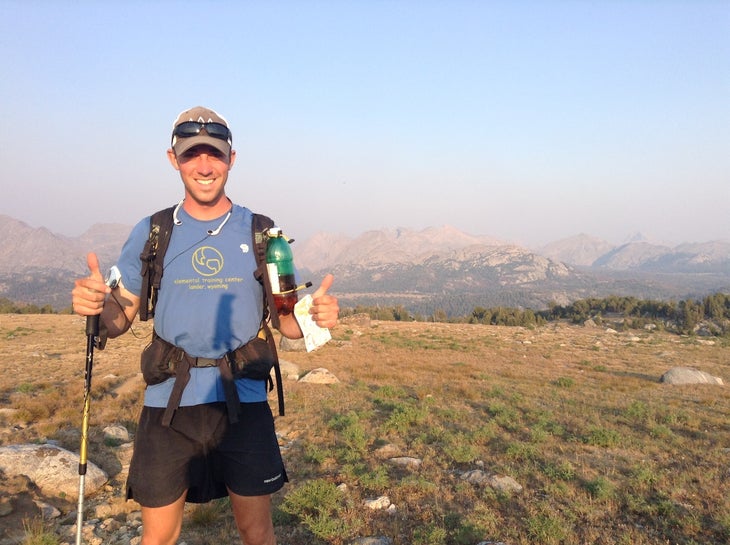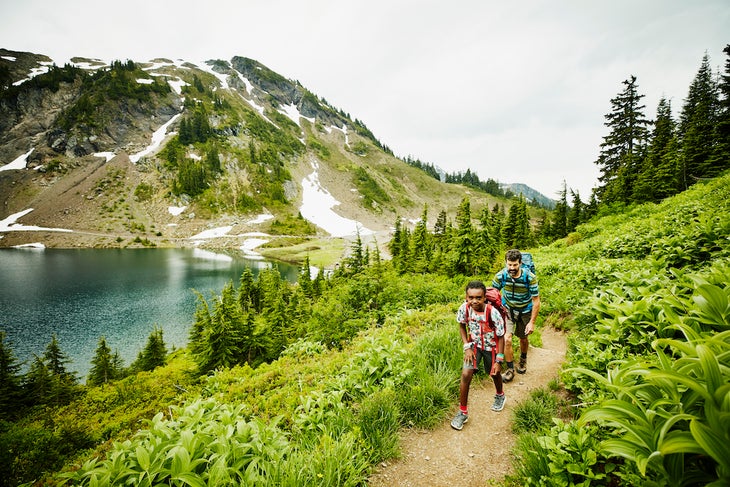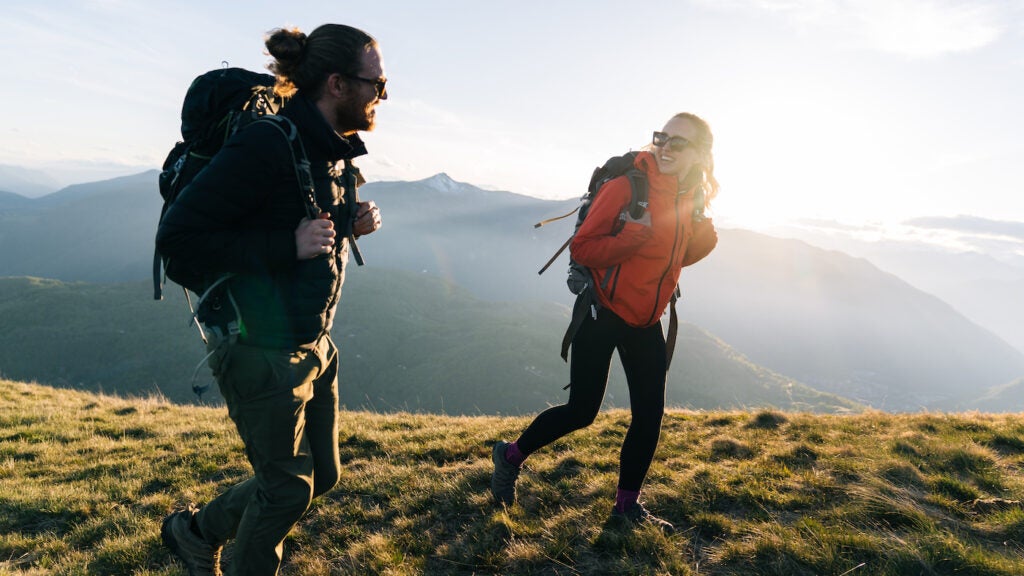Products You May Like
Heading out the door? Read this article on the new Outside+ app available now on iOS devices for members!
Download the app.
If you’re gearing up for a long-distance hike, there are ways to prepare your body for the rigors of life on the trail. You dial up your cardio to boost endurance, incorporate resistance training for joint stability and climbing power, and strengthen your core to protect your back and shoulders.
All of that fine-tunes the body, but what do you do to prepare your mind to stay focused and motivated once the novelty of the great outdoors begins to wane? On day one, when your clothes are dry and your canteen is full, you’re thrilled for the adventure ahead. But after days or weeks of bad weather, blisters, gear problems, and the monotony of the hike/eat/sleep/repeat cycle, it becomes harder to keep the stoke up, which you need to persevere when the going gets rough.
Getting in the right frame of mind for a lengthy trek starts long before your expedition starts, and staying there is a skill that takes time and practice to develop. We asked an exercise psychologist and some experienced hikers to weigh in on how to stay centered when a long hike starts to feel endless.

Pre-Hike: Get Your Head in the Game
Before you set out, ask yourself: “Why am I doing this?”
“Probably one of the biggest mental things to get sorted is identifying the reasons why you want to do it and what you’re hoping to get out of the experience,” says Cole Noble, a Colorado-based hiker and adventure writer.
Defining a “why” that’s tied to what you value—whether that’s nature and wildlife, physical health, or something else entirely—will sweeten personal victories and motivate you to keep going during challenging moments. However, if conquering a trail feels like something you should do, or most of your motivation comes from external approval rather than internal purpose, you may struggle to stay focused, especially when dealing with stressful or uncomfortable situations.
And, yes, at times you will be stressed. And uncomfortable, hungry, thirsty, annoyed, exhausted, and bored. Planning for these low points is what clinical and performance psychologist Jonathan Fader, Ph.D., refers to as “stress inoculation.”
“One of the biggest mistakes people make with imagery is that they imagine things in an idyllic way,” he says. It’s fun to envision the beautiful vistas, that sense of camaraderie with your hiking partners, and how strong you’ll look and feel after a couple of rewarding days on the trail. Although there’s power in positive visualization, it can be just as useful to think through the obstacles you’ll likely bump up against, whether that’s blisters around day three, homesickness two weeks in, or anxiety leading up to a tricky checkpoint.
“It does help people through stress inoculation to imagine themselves going through the steps of the hike and imagining those difficult trajectories and what they’re going to do both physically and mentally to respond to them,” Fader says. “That way, when they get there, it’s more second nature.”
Physically rehearsing some of what you’ll encounter on the trail is also critical. Noble recommends doing shorter, easier hikes to practice basic backpacking skills so that logistical or gear-related problems don’t compound the exhaustion and mental hurdles you might face on your big adventure: “You don’t want to be trying to light your stove for the first time. You don’t want to be trying to put your tent up for the first time.” Having skills like these down to a science will not only save you time and frustration but will also boost your sense of confidence and self-efficacy on the trail.

Gratitude and Staying Present
According to Charlie Manganiello, an experienced thru-hiker and strength and conditioning coach at Elemental in Lander, Wyoming, staying present is one of the biggest challenges long-distance hikers face. During his time on the Pacific Crest Trail (PCT) and Continental Divide Trail (CDT), he realized that, despite his athleticism, he couldn’t move much faster than 3 or 4 miles per hour, which meant back-to-back 12-hour days on the trail.
“You can’t be thinking about the end, or it can actually kind of destroy you,” he says. “On these thru-hikes, if you’ve already done 1,000 miles, for a lot of them, you still have another 2,000 miles left. And if you keep thinking about the 2,000 miles, you’re kind of dead in the water in terms of mental toughness.”
Over time, Manganiello learned to shift his focus to short-term goals, such as reaching the next campsite, and appreciate whatever he was experiencing in the moment. “There’s beauty in the fact that you can’t rush it,” he says. “You’ve got to enjoy the new vistas or enjoy the wildlife or just enjoy letting your thoughts go wild and see where they take you.” This mindset grounded him and prevented his mind from zooming out too far and getting overwhelmed by the trail.
Gratitude, Fader explains, is not only one of the best antidotes to the frustrations backpackers face on an expedition, but it can also strengthen the relationship between hiking partners and groups: “A gratitude practice, either by journaling or just saying to your hiking partner, ‘Wow, remember this thing we saw today?’ or, ‘This struck me as particularly beautiful for this reason,’ or ‘We are so lucky to do this.’ That inoculates you to all the little stressors and physical ailments that happen on a hike.”

When to Keep Pushing and When to Stop
Part of developing mental toughness is learning how to respond to the body’s “central governor,” a concept that Fader describes as a function of the nervous system. “Humans are very much programmed for homeostasis and survival, and once you start pushing yourself, your body starts messaging you to stop,” he explains. Triggered by feelings like exhaustion, pain, and fear, the central governor is a protective mechanism, but it can activate long before the body is in any kind of real peril. When the central governor kicks in with messages like “stop,” “give up,” or “let’s go home,” you have the choice to talk back.
“What I usually work on with endurance athletes is to respond to those central governor messages, saying, ‘Thanks for the suggestion, but we’re going to continue,’” Fader says. This practice can help you establish that you’re in control, not beholden to your central governor. It can also teach you to employ instructional self-talk, another practical skill on the trail.
“Most people think that self-talk has to be motivational or positive, but that’s really not the case. Some of the powerful self-talk is instructional,” Fader says. Talking yourself through the necessary motions, like putting one step in front of the other, can help you push through trying moments mentally.
However, when you’re in the wilderness, balancing perseverance and tenacity with reality and humility is critical. Sometimes a relentless “can-do” attitude in an uncontrolled environment is dangerous.
“You have a really tough tightrope to walk because, on the one hand, you have to push yourself through some pain and discomfort. It’s not going to be a walk in the park,” Noble says. “But on the other hand, you have to be realistic with yourself about your limitations.” Soldiering on amidst hazardous trail conditions, severe weather, or serious injuries can be life-threatening or simply impossible. In situations where continuing is dangerous or harmful, it’s a sign of strength to stop or change course.
Manganiello faced this dilemma when severe tendonitis forced him off the CDT about a thousand miles into his trip. When he could no longer extend his foot and had to climb down every hill backward, he knew it was time to let his body recover.
This derailment was disappointing, he says, but his biggest regret is how he responded to the setback: “It was all or nothing for me, and I couldn’t just let go of the fact that I got injured and I was going to miss part of the trail.” He had the opportunity to rejoin his crew 150 miles down the trail, but he fixated on those missed miles and eventually left the trail before finishing the hike.
Ten years later, he wishes he’d demonstrated another aspect of mental toughness in that moment: the humility and flexibility to adapt.
There’s no perfect hike. The wilderness is unpredictable, the most experienced backpackers will make mistakes, and even the fittest athletes get injured. Being able to control your thoughts, instead of having your thoughts control you, is the best way of making it to the end of a mentally challenging hike.
“Since then, I’ve had plenty of moments where I could have gotten pissed off and not finished something because it was not my stated goal,” Manganiello says. “But now I use my experience. I’m like, ‘It might not be exactly what I said I was going to do, but it’s going to be an amazing day.’”
